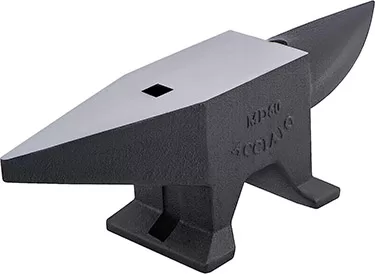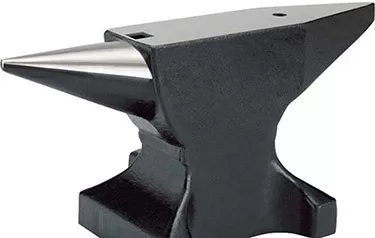We’ve been getting a lot of questions from all levels of blacksmiths about getting into knife making. Among those questions, the most common is “What’s the best anvil to get for knife making?”
Since anvils are notoriously difficult to purchase, move, and get rid of, it’s crucial to buy the right one, the first time!
Depending on your level of knife making as well as the type of knives you plan on making, figuring out which anvil is right for you can be confusing.
To help you out, we’ve rounded up some of the best anvils on the market, that can be used to make all types of knives.
In this blog post, we’ll take a look at multiple anvils designed for knife making. We’ll cover all the features, pros and cons, and a detailed buyer’s guide to help you find the anvil that will suit your needs.
Best Anvils for Knife Making
- Vevor (Best for Beginners)
- Rigid Model (Best for Experts)
- NC KnifeMaker Anvil (Best for Versatility)
Vevor 132Lbs (Best for Beginners)

If you’re just starting out making knives, you will want an anvil that’s sturdy, reliable, and won’t break the bank. Many blacksmiths, including myself, have had great success with the Vevor 132lbs Anvil.
The Vevor anvil has a large face which is necessary for beginner knife makers, which gives you adequate surface space to perfect your hammering skills. The sturdy base is another feature that you will learn to appreciate as a beginner.
The anvil is made of high-grade steel and features a single horn design which might not be useful for forging knives, but is great for other blacksmithing projects.
| Pros |
|---|
| Cons |
|---|
Rigid Peddinghaus (Best for Experts)

Trying to buy an anvil can be difficult, even for expert knife makers. There just aren’t many companies out there that still make high-grade anvils. Luckily, you can still purchase the Rigid Peddinghaus anvil, which is considered one of the best on the market.
It comes in 3 different sizes that are suitable for all levels of bladesmiths;
- Model 5: 77 lbs with an 8′ face
- Model 9: 165 lbs with a 10.5′ face
- Model 12: 275 lbs with a 12′ face
Although the price point may not fit most beginner blacksmiths’ budgets, some may prefer to start off with quality and avoid “could’ve/should’ve” regrets.
However, for seasoned bladesmiths, the German-Made Rigid Peddinghaus is worth every penny. It’s drop-forged from high-grade steel, making it incredibly durable and reliable. The top face is ground and induction hardened to provide a precise surface for metalworking projects. I measured the hardness at a whopping 56 HRc!
It’s also one of the easiest to purchase. You can find it in several online shops and even here on Amazon. Lastly, the 235mm x 275mm base provides added stability when hammering.
Overall, I highly recommend the Ridgid anvil for expert knife makers as well as beginners who are willing to invest in quality. It’s a great investment that will last a lifetime!
| Pros |
|---|
| Cons |
|---|
NC Tools KnifeMaker Anvil (Best for Versatility)

The NC Tool Knifemaker Anvil is a popular choice among knife makers and blacksmiths due to its versatility and well-balanced design. Weighing 70 pounds, this anvil features a large work surface, a single horn, and a turning cam, making it suitable for a wide range of projects.
Constructed from ductile iron, the NC Tool Knifemaker Anvil is heat-treated to achieve a hardness of 48 HRc, ensuring durability and longevity.
The anvil’s tapered heel and “turning cam” make it ideal for bending and shaping metal.
| Pros |
|---|
| Cons |
|---|
How to Choose an Anvil for Knife Making
Anvils come in a variety of shapes and sizes and choosing the right one can be overwhelming. Here are some things to consider when selecting an anvil for knife making.
Anvil Size Matters
The most critical factor when selecting an anvil is size.
A larger anvil will allow you to forge longer knives and even swords. It will withstand heavier pounding and accommodate a wider variety of tools. But larger anvils come with a couple of downsides. They are more expensive and are very difficult to move.
On the other hand, a smaller anvil is more affordable, easier to move around, and takes up less space. But you will be limited to the size of knives you can forge on it as well as having to be more careful not to hit the anvil too hard.
Weight: Stability vs. Maneuverability
Just like size, the weight of an anvil is another critical factor to consider. A heavier anvil is more stable and can withstand harder hammering, but it can be harder to move around.
With that said, a lighter anvil will be easier to maneuver, cheaper, and easier to purchase. However, it won’t withstand heavy hammering and may even crack or break if you go too hard.
So, it all boils down to personal preference here. If you want to take bladesmithing more seriously, “buy right” the first time and go for the heavier one (you won’t regret it). But if you just want to dabble and get your feet wet, start with a lighter one and work your way up.
Face: Flat and Hard
The anvil face is where all the action happens, so it’s important to make sure that it’s flat and hard. A flat surface will make it easier to forge knives and tools in a consistent manner.
The hardness of the anvil face is also important, as it needs to endure the punishment that comes with bladesmithing. Generally speaking, an anvil should have a Rockwell hardness (HRc) rating between 50-56 for optimal performance.
Horn Shape and Size
Not all anvils have a horn, and it’s not necessary for all blacksmithing projects. However, for knife making, the horn is invaluable for forming and shaping blades. So, make sure that your anvil has a horn if you plan on doing any serious knife-making.
When it comes to size and shape, most horns are either straight or curved (or a bit of both). The length also varies from 6″ up to 18″, depending on the size of the anvil.
Pritchel Hole
The pritchel hole is a small hole located in the center of most anvils. It’s used for punching and drilling holes through the steel. It’s also not found on all anvils and isn’t a critical feature for making a knife. But having a pritchel hole does come in handy for many other blacksmithing projects.
Hardy Hole (Tool Holder)
The hardy hole is a square-shaped hole usually located near the horn of an anvil. Its main purpose is to serve as a place to accommodate special tools known as “hardy tools”.
Although hardy holes typically come in a standard size and shape. You should double-check when buying an imported anvil, especially anvils that originate from the UK.
Price: Quality vs. Cost
Finally, the most important factor of all is price. Anvils can range in price from less than a hundred dollars to thousands, so you’ll have to choose one that fits your budget.
That said, it’s important to remember that quality comes at a cost. Investing in a more expensive anvil will ensure you get a piece of high-quality equipment that will last for many years.
On the other hand, a cheaper anvil may not be able to take much punishment and may end up needing to be replaced sooner rather than later.
Conclusion
In conclusion, when choosing an anvil for knife making, size, weight, face, horn, pritchel hole, hardy hole, and price are all key factors to consider.
I found the Vevor to be the best anvil for beginner knife makers, while the Rigid Peddinghaus perfect for serious bladesmiths.
It’s important to find an anvil that fits your needs and budget while not sacrificing quality. Take the time to weigh your options and make an informed decision.
